Howitzer
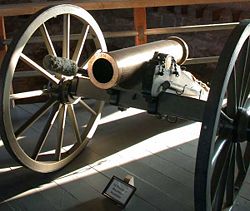
A howitzer is a type of artillery piece that is characterized by a relatively short barrel and the use of comparatively small explosive charges to propel projectiles at trajectories with a steep angle of descent. In the taxonomies of artillery pieces used by European (and European-style) armies in the 18th, 19th, and 20th centuries, the howitzer stood between the "gun" (which was characterized by a longer barrel, larger propelling charges, smaller shells, higher velocities and flatter trajectories) and the "mortar" (which has the ability to fire projectiles at even higher angles of ascent and descent).
Contents |
Etymology
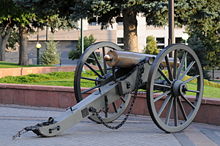

The English word howitzer derives from the German word Haufen (heap) which as Gewalthaufen designated a pike square formation. Already in the Battle of Tannenberg (1410), the Teutonic Knights used artillery[1] which was intended to break up enemy formations. During the Hussite Wars of the 1420s and 1430s, the Czechs used short barreled "houfnice"[2] cannons to fire at short distances into such crowds of Haufen infantry ("houf" came in use as the Czech word for crowd[3]), or, to make horses skittish, into charging heavy cavalry.[4] From the aufeniz mentioned in 1440 derive the German Haussnitz and later Haubitze, the Swedish haubits, Italian obice, and the Dutch word houwitser which led to the English word howitzer .
Since the First World War, the word "howitzer" has been increasingly used to describe artillery pieces that, strictly speaking, belong to the category of "gun-howitzer". This is particularly true in the armed forces of the United States, where gun-howitzers have been officially described as "howitzers" for more than sixty years. Because of this practice, the word "howitzer" is used in some armies as a generic term for any kind of artillery piece that is designed to strike targets on land. Thus, a number of artillery pieces that bear little resemblance to howitzers of earlier eras, such as the multi-chamber "supergun" designed by the Canadian artillery expert Gerald Bull for Iraq in the 1980s, are sometimes described as "howitzers".
The British had a further method of nomenclature that they adopted in the 19th century. Guns were categorised by projectile weight in pounds while howitzers were categorised by calibre in inches. This system broke down in the 1930s with the introduction of gun-howitzers.
History

The first modern howitzers were invented in Sweden towards the end of the seventeenth century. These were characterized by a shorter trail than other field guns meaning less stability when firing, which reduced the amount of powder that could be used; armies using these had to rely on a greater elevation angle to achieve a given range, which gave a steeper angle of descent.
Originally intended for use in siege warfare, they were particularly useful for delivering cast-iron shells filled with gunpowder or incendiary materials into the interior of fortifications. In contrast to contemporary mortars, which were fired at a fixed angle and were entirely dependent upon adjustments to the size of propellant charges in order to vary range, howitzers could be fired at a wide variety of angles. Thus, while howitzer gunnery was more complicated than the technique of employing mortars, the howitzer was an inherently more flexible weapon that could fire its projectiles along a wide variety of trajectories.[5]
In the middle of the eighteenth century a number of European armies began to introduce howitzers that were mobile enough to accompany armies in the field. Though usually fired at the relatively high angles of fire used by contemporary siege howitzers, these field howitzers were rarely defined by this capability. Rather, as the field guns of the day were usually restricted to inert projectiles (which relied entirely upon momentum to achieve their destructive effects), the field howitzers of the eighteenth century were chiefly valued for their ability to fire explosive shells. Many, for the sake of simplicity and rapidity of fire, dispensed with adjustable propellant charges.[6]
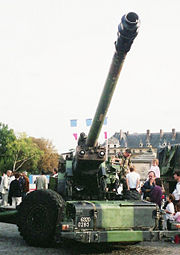
In the mid-nineteenth century, some armies attempted to simplify their artillery parks by introducing smoothbore artillery pieces that were designed to fire both explosive projectiles and cannonballs, thereby replacing both field howitzers and field guns. The most famous of these "gun-howitzers" was the Napoleon 12-pounder, a weapon of French design that saw extensive service in the American Civil War.[7]
In 1859 the armies of Europe (to include those which had recently adopted gun-howitzers) began to rearm their field batteries with rifled field guns. These new field pieces used cylindrical projectiles that, while smaller in calibre than the spherical shells of smoothbore field howitzers, could carry a comparable charge of gunpowder. Moreover, their greater range combined allowed them to create many of the same effects (such as firing over low walls) that had previously required the sharply curved trajectories of smoothbore field howitzers. Because of this, military authorities saw no point in obtaining rifled field howitzers to replace their smoothbore counterparts but, instead, used rifled field guns to replace both guns and howitzers.[8]
In siege warfare the introduction of rifling had the opposite effect. In the 1860s artillery officers discovered that rifled siege howitzers (which were substantially larger than field howitzers) were a much more efficient means of destroying walls (and particularly walls that were protected by intervening obstacles of certain kinds) than either siege guns or siege mortars. Thus, at the same time that armies were taking howitzers of one sort out of their field batteries, they were introducing howitzers of another sort into their siege trains and fortresses. The lightest of these weapons (which would later become known as "light siege howitzers") had calibers in the vicinity of 150 mm or so and fired shells that weighed between 40 and 50 kilograms. The heaviest (which would later be called "medium siege howitzers") had calibers between 200 mm and 220 mm and fired shells that weighed about 100 kilograms(220 pounds). [9]
During the 1880s a third type of siege howitzer was added to inventories of a number of European armies. With calibers that ranged between 240 mm and 270 mm and shells that weighed more than 150 kilos, these soon came to be known as "heavy siege howitzers." A good example of a weapon of this class is provided by the 9.45-inch (240 mm) weapon that the British Army purchased from the Skoda works in 1899. Intended for use against the fortifications of Pretoria, which fell before the howitzer could be used, and subsequently deployed to China for use against the fortifications of Peking, which also fell without a siege, the 9.45-inch (240 mm) howitzer was never fired in anger.
In the early 20th century the introduction of howitzers that were significantly larger than the heavy siege howitzers of the day made necessary the creation of a fourth category, that of "super-heavy siege howitzers". Weapons of this category include the famous Big Bertha of the German Army and the 15-inch (381 mm) howitzer of the Royal Marine Artillery. These large howitzers were transported mechanically rather than by teams of horses. They were transported as several loads and had to be assembled on their firing position.
In the Russo-Turkish War of 1877-1878 the inability of rifled field guns to inflict significant damage upon field fortifications led to a revival of interest in field howitzers. By the 1890s a number of European armies fielded either light (105 mm to 127 mm) or heavy (149 mm to 155 mm) field howitzers and a few, such as that of Germany, fielded both.
These field howitzers introduced at the end of the nineteenth century could fired shells with high trajectories giving a steep angle of descent and, as a result, could strike targets that were protected by intervening obstacles. They could also fire shells that were about twice as large as shells fired by guns of the same size. Thus, while a 75 mm field gun that weighed one ton or so was limited to shells that weighed less than 8 kilograms, a 105 mm howitzer of the same weight could fire 15 kilogram shells. This is a matter of fundamental mechanics affecting the stability and hence the weight of the carriage. However, howitzers had a shorter maximum range than the equivalent gun.
As heavy field howitzers and light siege howitzers of the late nineteenth and early twentieth centuries used ammunition of the same size and types, there was a marked tendency for the two types to merge. At first this was largely a matter of the same basic weapon being employed on two different mountings. Later, as on-carriage recoil-absorbing systems eliminated many of the advantages that siege platforms had enjoyed over field carriages, the same combination of barrel assembly, recoil mechanism and carriage was used in both roles.
By the early 20th century the differences between guns and howitzers were relative not absolute and generally recognised[10] as follows:
- Guns - higher velocity and longer range, single charge propellant, maximum elevation generally less than 35 degrees.
- Howitzers - lower velocity and shorter range, multi-charge propellant, maximum elevation typically more than 45 degrees.
The onset of trench warfare after the first few months of First World War greatly increased the demand for howitzers that gave a steep angle of descent, which were better suited than guns to the task of striking targets on a horizontal plane (such as trenches), with large amounts of explosive and considerably less barrel wear. The German army was well equipped with howitzers, having far more at the beginning of the war than France.[11]
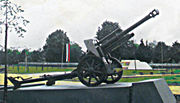
Many howitzers introduced in the course of World War I had longer barrels than pre-war howitzers. The standard German light field howitzer at the start of the war (the 10,5 cm leichte Feldhaubitze 98/09) had a barrel that was 16 calibres long, but the light field howitzer adopted by the German Army in 1916 (105 mm leichte Feldhaubitze 16, see on the left) had a barrel that was 22 calibres long. At the same time, new models of field gun introduced during that conflict, such as the 77 mm field gun adopted by the German Army in 1916 (7,7 cm Feldkanone 16) were often provided with carriages that allowed firing at comparatively high angles, and adjustable propellant cartridges. [12]In other words, there was a marked tendency for howitzers to become more "gun-like" while guns were taking on some of the attributes of howitzers.
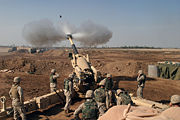
In the years after World War I, the tendency of guns and howitzers to acquire each other's characteristics led to the renaissance of the concept of the gun-howitzer. This was a product of technical advances such as the French invention of autofrettage just before World War I, which led to stronger and lighter barrels, the use of cut-off gear to control recoil length depending on firing elevation angle, and the invention of muzzle brakes to reduce recoil forces. Like the gun-howitzers of the nineteenth century, those of the twentieth century replaced both guns and howitzers. Thus, the 25-pounder "gun-howitzer" of the British Army replaced both the 18-pounder field gun and the 4.5-inch howitzer. While this had the effect of simplifying such things as organization, training and the supply of ammunition, it created considerable confusion in the realm of nomenclature.
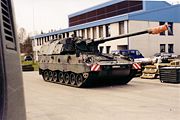
In the US Army, however, the preferred term was "howitzer". What is true for English, moreover, is also true for many other European languages. Thus, as gun-howitzers replaced both guns and howitzers, words such as "obusier" (French) and "Haubitze" (German), which had originally been used to designate weapons with relatively short barrels, were applied to weapons with much longer barrels.
Since World War II most of the artillery pieces adopted by land armies for attacking targets on land have combined the traditional characteristics of guns and howitzers—high muzzle velocity, long barrels, long range, multiple charges and maximum elevation angles greater than 45 degrees. The term 'gun-howitzer' is sometimes used for these (eg in Russia), many nations use howitzer while the UK calls them guns.
Types
- A self-propelled howitzer is mounted on a tracked or wheeled motor vehicle. In many cases, it is protected by some sort of armor so that it superficially resembles a tank.
- A pack howitzer is a relatively light howitzer that is designed to be easily broken down into several pieces, each of which is small enough to be carried by a mule or a packhorse.
- A mountain howitzer is a relatively light howitzer designed for use in mountainous terrain. Most, but not all, mountain howitzers are also pack howitzers.
- A siege howitzer is a howitzer that is designed to be fired from a mounting on a fixed platform of some sort.
- A field howitzer is a howitzer that is mobile enough to accompany a field army on campaign. It is invariably provided with a wheeled carriage of some sort.
Examples
- Tsar Cannon, the largest howitzer ever made, although never fired
- BL 6-inch 26 cwt British howitzer of the First World War
- QF 25 pounder British gun-howitzer of the Second World War
- L118 Light Gun British towed gun-howitzer of the late twentieth century
- M198 howitzer US towed gun-howitzer of the late twentieth century
- M777 howitzer British towed gun-howitzer of the early twenty-first century
- M109 howitzer US self-propelled gun-howitzer of the late twentieth century
- SSPH Primus Singaporean self-propelled gun-howitzer of the early twenty-first century
- PzH 2000 German self-propelled gun-howitzer of the early twenty-first century
- M110 howitzer US self-propelled gun-howitzer of the late twentieth century
- G5 howitzer South African towed gun-howitzer of the early 1980s.
- For more examples, see List of artillery
See also
References
- ↑ Stephen R. Turnbull: Tannenberg 1410 Disaster for the Teutonic Knights, p. 45
- ↑ Stephen Turnbull: The Hussite Wars, 1419-36 [1]
- ↑ Christopher Gravett: German Medieval Armies 1300-1500 [2]
- ↑ The Shorter Oxford English Dictionary, (Oxford: The Clarendon Press, 1973), I, p. 992
- ↑ OFG Hogg Artillery: its Origin, Heyday and Decline (London: C Hurst & Co, 1970), pp. 94
- ↑ Heinrich Rohne, "Zur Geschichte der schweren Feldhaubitze", Jahrbücher für die deutsche Armee und Marine, No. 423, pp. 567-68
- ↑ Ildefonse Favé, “Résumé des Progrès de l’Artillerie Depuis l’Année 1800 Jusqu’a L’Année 1853”, in Louis-Napoléon Bonaparte and Ildefonse Favé, Études sur le passé et l'avenir de de l'artillerie, (Paris: J. Dumaine, 1846-71), V, pp. 223-25
- ↑ Charles Thoumas, Les transformations de l'Armée française: essais d'histoire et de critique sur l'état militaire de la France, (Paris : Berger-Levrault, 1887), II, pp. 123-26
- ↑ Hermann von Müller, Die Entwickelung der deutschen Festungs und Belagerungstrains, (Berlin: E. S. Mittler, 1896), pp. 328-35
- ↑ HA Bethell, Modern Guns and Gunnery, (Woolwich: FJ Cattermole, 1905, 1907, 1910)
- ↑ Gudmundsson, Bruce I. (1993). On Artillery. Greenwood Publishing Group. ISBN 0275940470.
- ↑ Hans Linnenkohl, Vom Einzelschuss zur Feuerwalze, (Koblenz: Bernard und Graefe, 1990), pp. 86 and 219-220